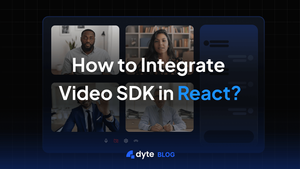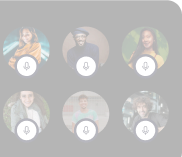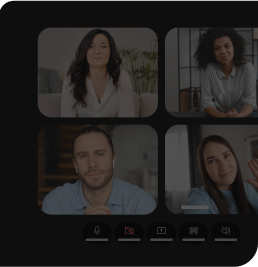In today's digital age, video calling is more relevant than ever. Integrating it into your React applications can make your apps more interactive and engaging. In this guide, we'll explore how to seamlessly integrate video calling using the Dyte Video SDK.
Overview of Dyte SDK and its advantages
Dyte is a robust video calling SDK tailored for developers. Some of its key advantages include:
- Ease of integration with modern web technologies, including React.
- High-definition video quality.
- Scalability and reliability.
Prerequisites
- A basic understanding of React. Familiarity with React components, states, and props will be beneficial.
- A Dyte account and access to the SDK. Sign up on the Dyte Developer Portal if you haven’t already.
- A new or existing React project to integrate with.
Setting up the environment
How to set up a new React project: If you're starting from scratch, you can initiate a new React project using Create React App:
npx create-react-app my-video-app
Installing necessary packages and dependencies: Once the project is set up, navigate to its root directory and install the necessary dependencies.
Dyte SDK setup
How to obtain the SDK key from the Dyte platform: Log in to your Dyte account, navigate to the 'API & SDK' section, and generate a new API key.
Installing the Dyte SDK: Using npm or yarn, you can integrate the SDK into your React project:
npm install dyte-sdk or yard add dyte-sdk
The concept behind video calling
How is Dyte different from WebRTC: While Dyte leverages the power of WebRTC, it simplifies the integration process and provides additional features out of the box.
Brief intro to how WebRTC works: WebRTC is a free, open-source project that enables real-time communication of audio, video, and data in web browsers and mobile applications.
The power of WebRTC lies in its ability to bring high-quality, real-time communication to the web, without requiring users to install plugins or third-party software. However, building a robust, scalable video communication solution from scratch using WebRTC can be challenging. This is where platforms like Dyte come into play, offering a simplified integration process while still harnessing the capabilities of WebRTC.
Learn more about WebRTC limitations and difference between WebRTC vs Managed WebRTC.
Basic integration
Initialising the Dyte SDK in your React component: Start by importing the SDK and initialising it with the provided SDK key.
Configuring the SDK: Set up listeners and event handlers to manage video call events. For example, on-call join, on-call end, etc.
Adding basic UI components: Incorporate elements like the video window, and buttons for mute/unmute, end call, and others, to facilitate user interactions.
Advanced features and customization
Customising the video call UI: With CSS and React components, you can design the UI to fit your brand’s aesthetics.
Advanced Dyte SDK features: Explore features like screen sharing, recording, and in-call chat to enhance the user experience.
Error handling and edge cases: Ensure your application can handle unforeseen events. For example, if the video call fails, gracefully notifying users is crucial.
Testing the video call functionality
Running your React app locally: Start your app using the npm start or yarn start command.
Initiating a video call: Once your app is running, try initiating a call and test the various features to ensure everything works as expected.
Common issues and troubleshooting tips: Look out for common pitfalls, such as not setting up listeners correctly or missing dependencies.
Optimizations and best practices
Ensuring the best video and audio quality: Regularly test the app in various conditions to maintain quality.
Reducing latency and improving call performance: Use optimised video resolutions and consider geographically distributed servers for low latency.
Deployment
Preparing your React app for production: Build your React app using the npm run build or yarn build command.
Deploying the app: Once built, deploy your app to your preferred server or hosting platform, like Vercel, Netlify, or any other.
When to use react
React, developed and maintained by Facebook, is one of the most popular JavaScript libraries for building user interfaces. Here's when you should consider using React:
- Component-Based Architecture: React's component-based structure helps in building reusable UI components, making development more modular and maintainable.
- Single Page Applications (SPA): React is perfect for SPAs where the content changes dynamically without reloading the entire page.
- Complex UIs: If your application requires rich user interfaces with real-time updates, React’s virtual DOM ensures efficient updates and rendering.
- When Using Other React Ecosystem Libraries: If you're leveraging other tools and libraries from the React ecosystem, such as Redux or React Router, it's logical to use React.
- Large Development Teams: React's component architecture can make collaboration easier among large development teams.
When not to use React
Every tool has its use case, and while React is powerful, there are scenarios where other tools might be more appropriate:
- Static Websites: For websites that don't need dynamic updates or have minimal interactivity, using React might be an overkill. Plain HTML/CSS or static site generators would be more efficient.
- SEO Needs: While React apps can be SEO-friendly with tools like Next.js, traditional server-rendered sites still have some advantages in SEO.
- Learning Curve: If your team isn't familiar with React or the JavaScript ecosystem, and there's a short timeline, the initial learning curve might pose challenges.
- Smaller Projects: For smaller projects with limited functionality, introducing React might complicate the build and deployment processes.
Dyte's React package
Dyte recognizes the extensive use of React in modern web development and thus provides a dedicated React package to simplify the integration process. Here's a glimpse into Dyte's React package:
- Tailored for React: It abstracts away many complexities, providing developers with React components ready to be imported and used in their applications.
- Ease of Integration: With just a few lines of code, you can have a video component ready in your application.
- Custom Hooks: The package often includes custom hooks, which allow you to tap into and utilise the core features of the Dyte SDK, leveraging the power and flexibility of React's hooks feature.
- Styling and Theming: The package provides ways to easily customise and theme the video components, ensuring consistency with the rest of your application.
Conclusion
We've walked you through integrating video calling into a React application using the Dyte SDK. Dive deeper, explore more features, and bring interactive video experiences to your users.
Further resources and reading
- Official Dyte SDK documentation: This is your go-to resource for any Dyte-related questions.
- Related articles or tutorials: Look for tutorials that offer more in-depth guidance on advanced Dyte SDK features.
- React best practices: Enhance your app's performance and user experience by following React's best practices.
Happy coding!




